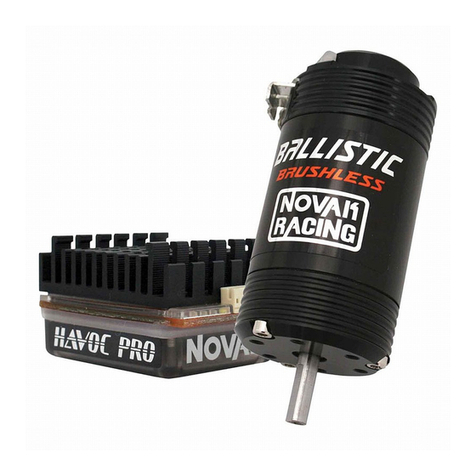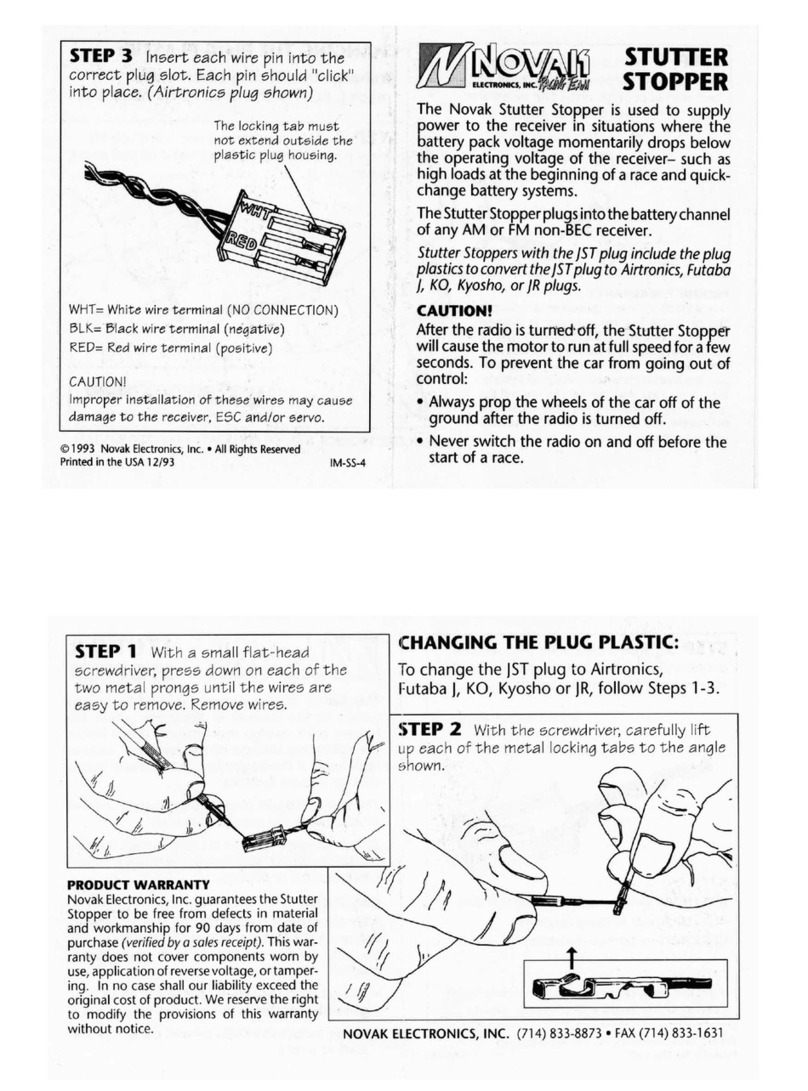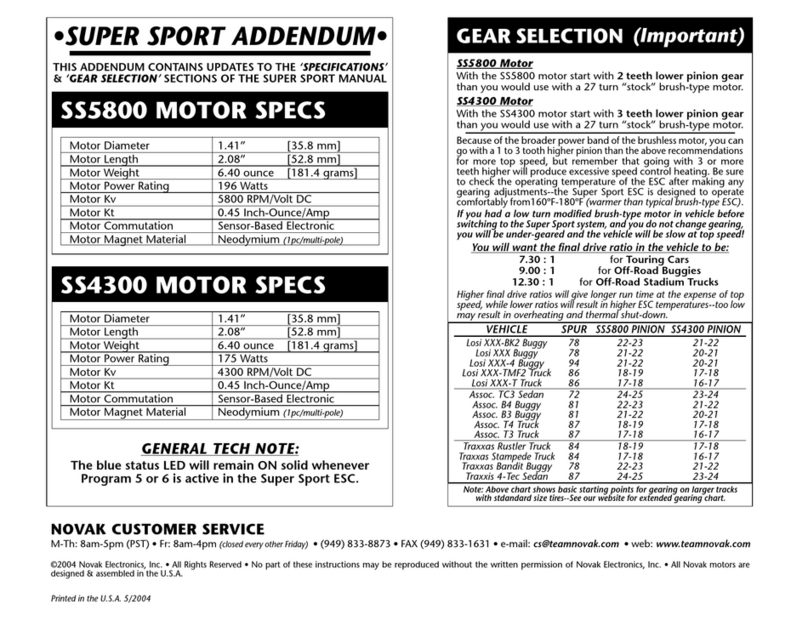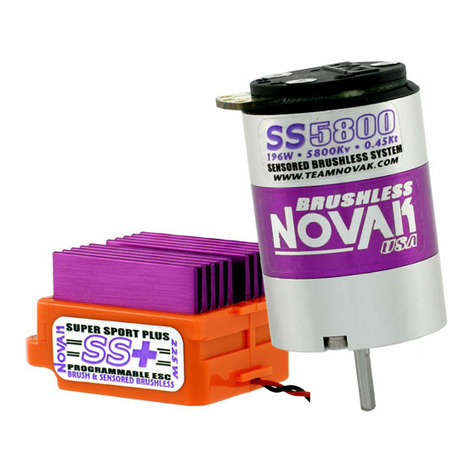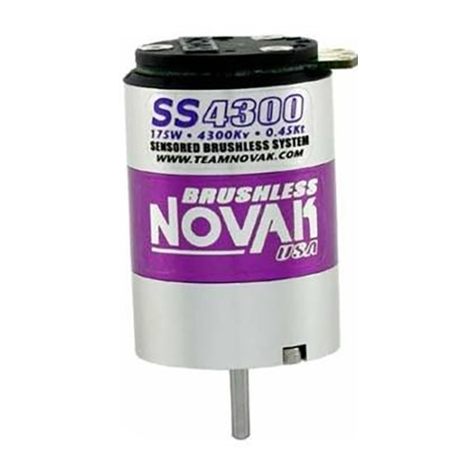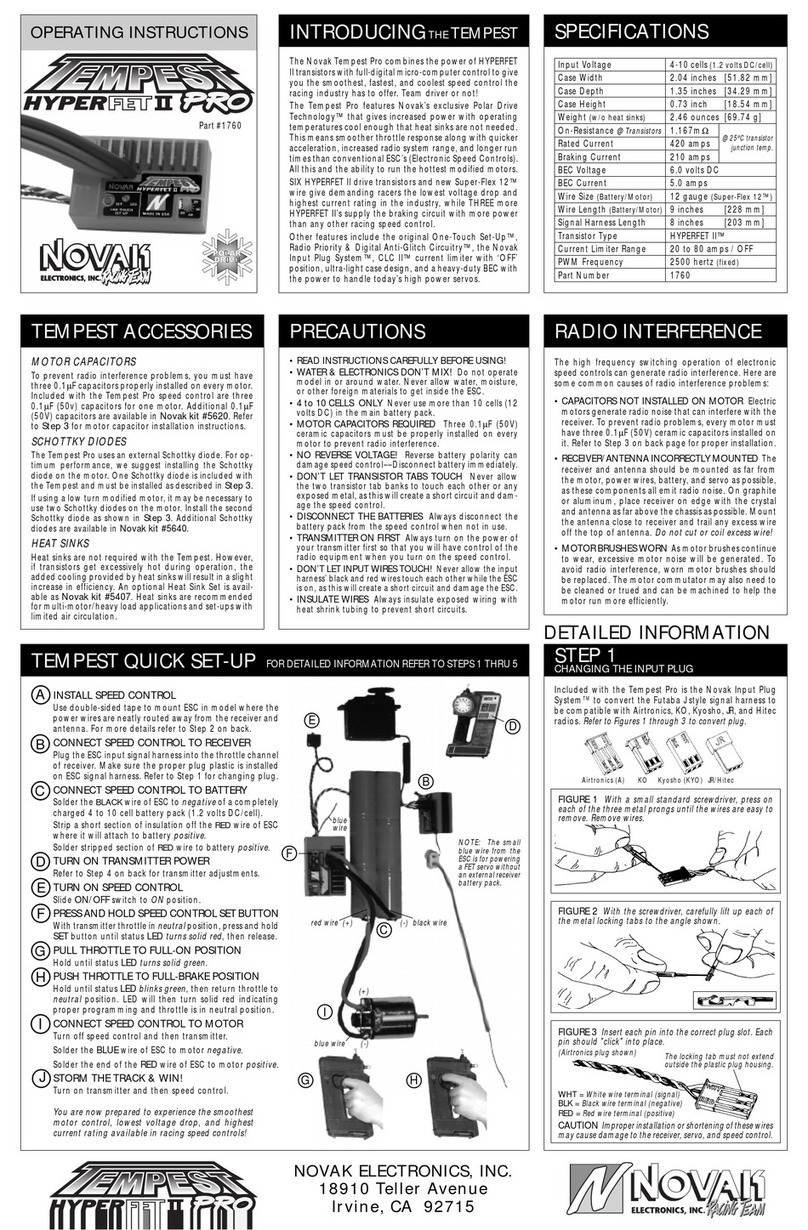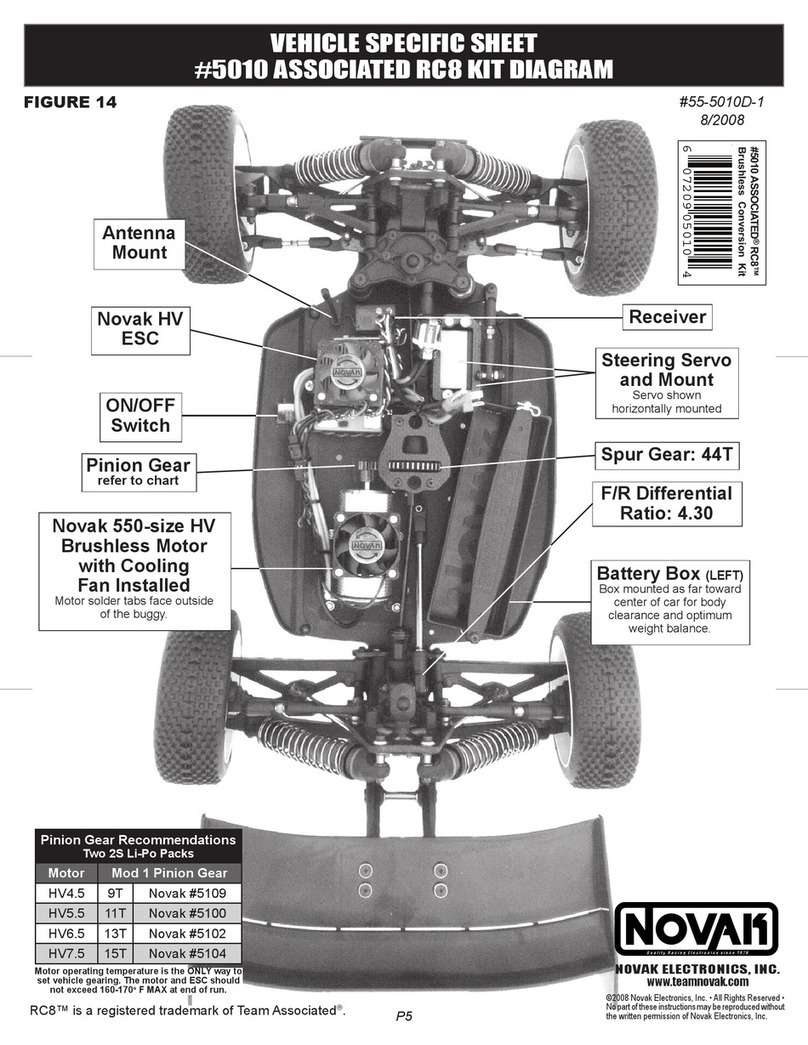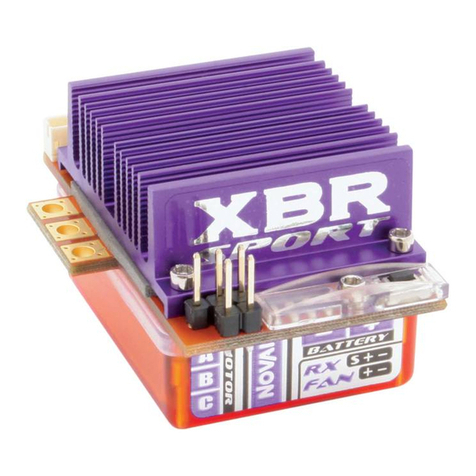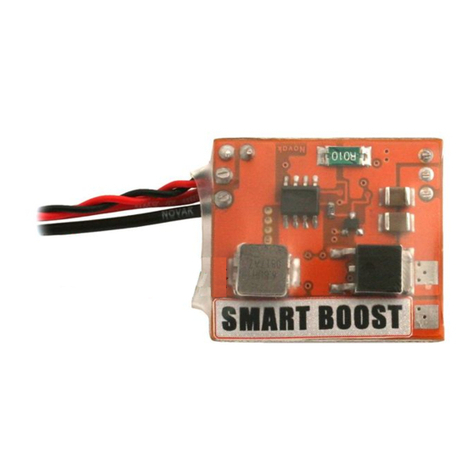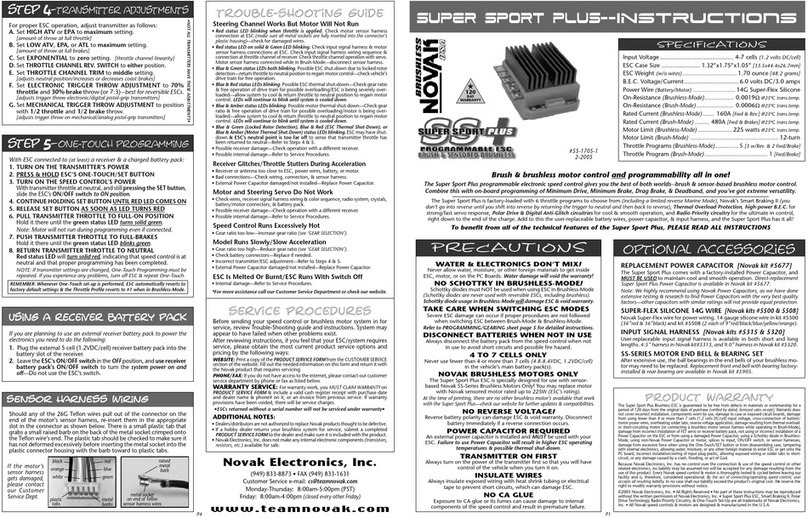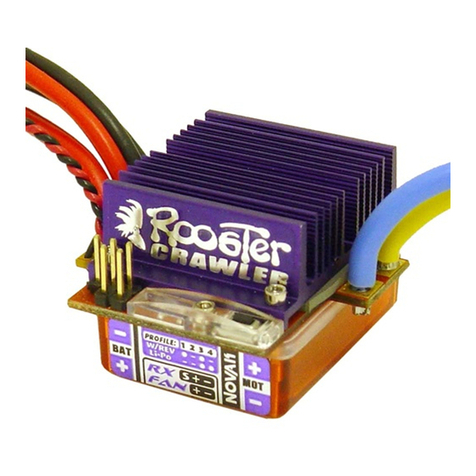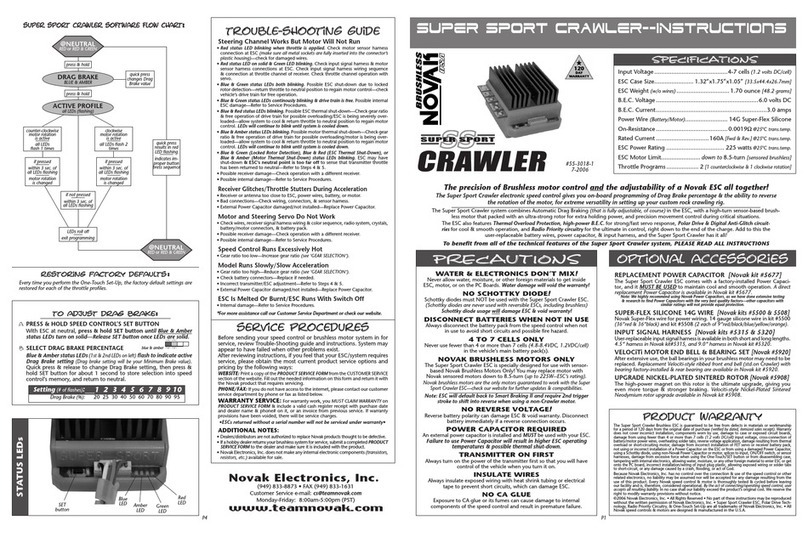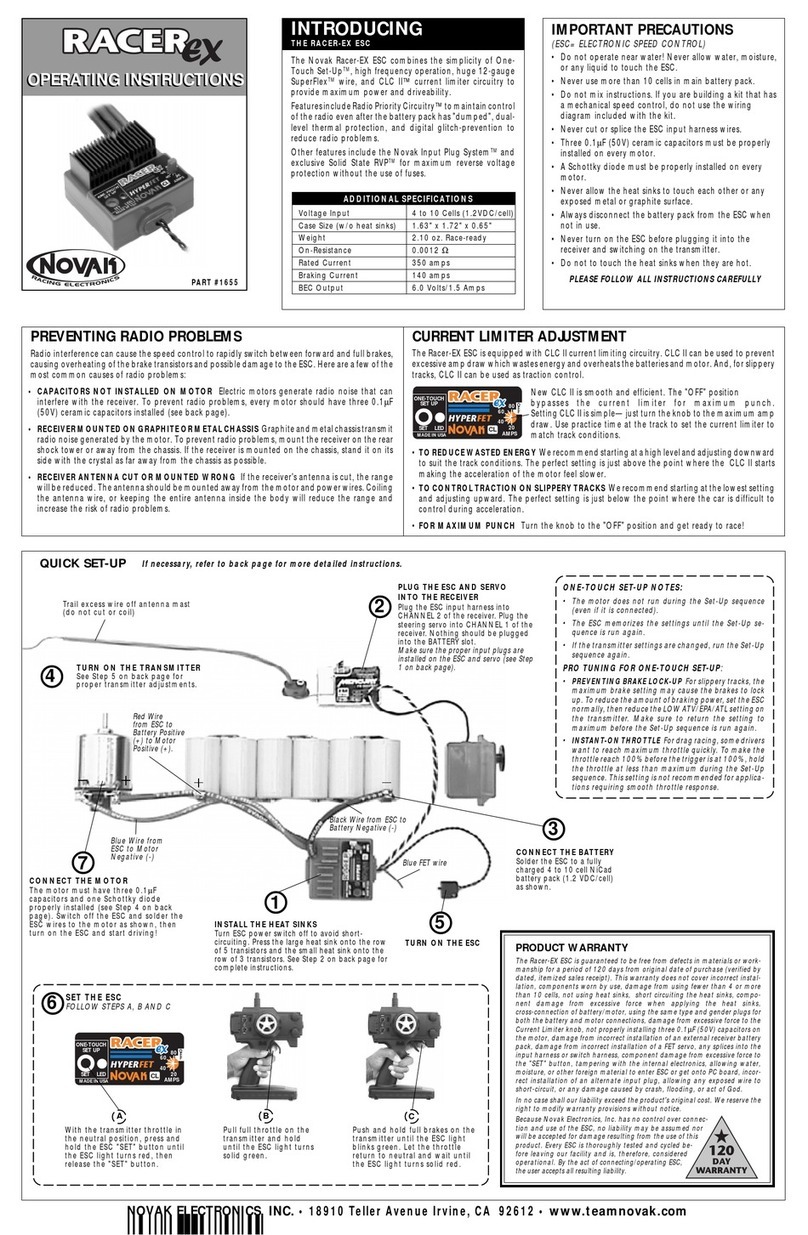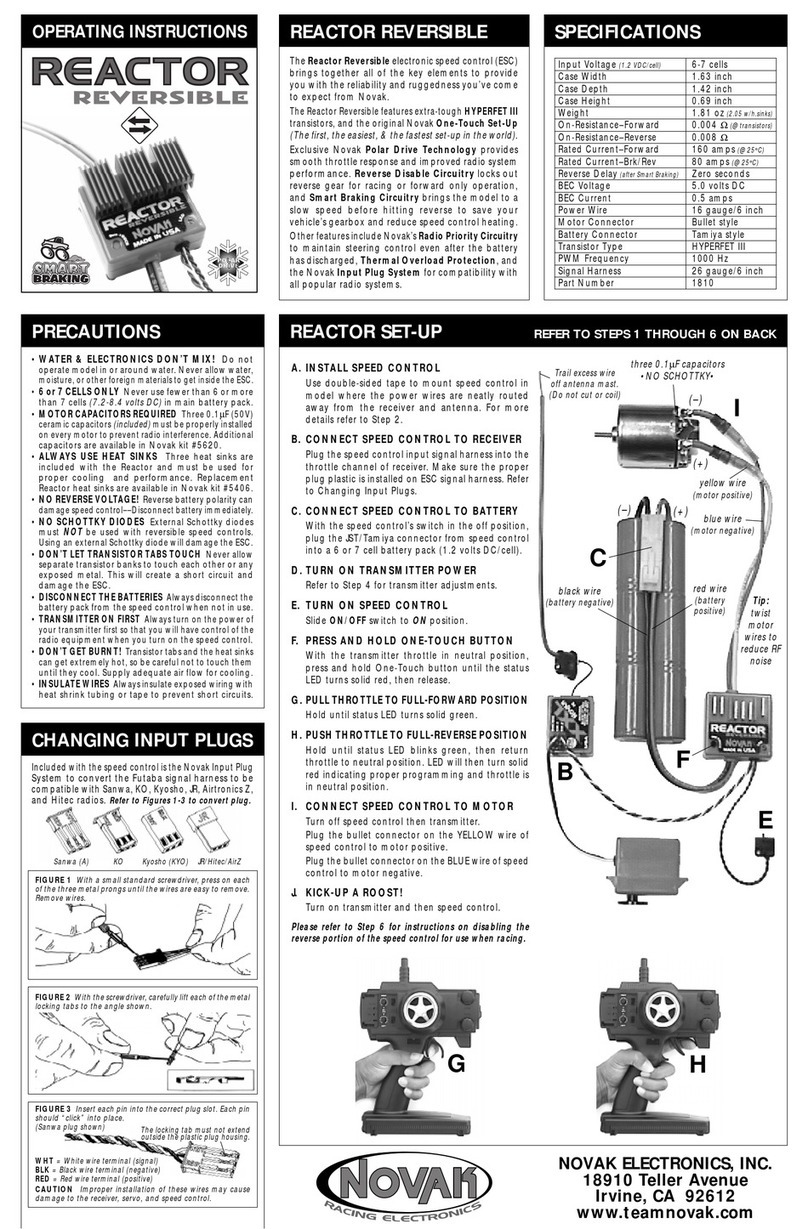#IM-1685-1
10-2004
SPECIFICATIONS
Input Voltage........................................ 6-14 cells (1.2 volts DC/cell)
Case Size .............................
1.75”x2.17”x0.85” [44.5x55.1x21.6mm]
Weight (w/o wires) ............................................. 4.03 ounce [114 grams]
On-Resistance @ Transistors/25°C .......................................... 0.0011 Ω
Rated Current
(forward/braking & reverse) ........................
400/180 amps
B.E.C. Voltage/Current............................... 6.0 volts DC/3.0 amps
Power Wire .............................................. 14G Super-Flex Silicone
Single Motor Limit @ 6 cells ................................................ None
Single Motor Limit @ 10, 12, & 14 cells ............
None (550 size only)
Dual Motor Limit @ 6 cells .......................... 10 Turns (550 size only)
Dual Motor Limit @ 10 cells.............................None (550 size only)
Dual Motor Limit @ 12 &14 cells .................
12 Turns (550 size only)
Throttle Program #1 ....................
Forward, Brakes, & 100% Reverse
Throttle Program #2 ....................
Forward & Brakes only (no reverse)
Throttle Program #3 .....................
Forward, Brakes, & 25% Reverse
High-Power Reversible ESC
BIG...BAD...POWERFUL...RELIABLE...........the SUPER DUTY XR is here!
The Super Duty XR is the toughest high-power reversible electronic speed control that you can get for your
big trucks, hot boats, or any other high-power R/C application using brush-type motors!
With 3 factory throttle programs to choose from & Novak’s Smart Braking II (you don’t go into reverse until you shift into reverse by returning the
trigger to neutral and then back to reverse), the Super Duty XR is ready for anything. The Super Duty XR has Thermal Overload Protection for peace
of mind, high-power B.E.C. for strong/fast servo response, Polar Drive & Digital Anti-Glitch circuitries for cool & smooth operation, and Radio
Priority circuitry for the ultimate in control, right down to the end of the battery power. Add to this the ease & convenience of user-replaceable
battery wires, power capacitor, ON/OFF switch, & input harness, and the Super Duty XR is super user-friendly!
To benefit from all of the Super Duty XR’s technical features, PLEASE READ ALL INSTRUCTIONS
POWER-BOOST ESC COOLING FAN KIT [Novak kit #5646]
The Power-Boost ESC cooling fan kit has everything needed to get more
power from your Super Duty XR for hot motors--custom fit fan brackets
(short & tall included), mounting screws, & high-volume cooling fan that
plugs into Super Duty XR’s fan power output jack.
POWER CAPACITORS [Novak kit #5675]
An external power capacitor is installed, and MUST BE USED to maintain
cool and smooth operation. Refer to Fig.5 Set-Up Photo
MOTOR CAPACITORS [Novak kit #5620]
Additional motor capacitors are available in Novak kit #5620.
SUPER-FLEX SILICONE POWER WIRE
[Novak kits #5500 & 5530]
Novak Super-Flex wire for motor & power wiring. 14 guage silicone wire in kit
#5500 (36”red & 36”black), and 12G silicone in kit #5530 (36”red & 36”black).
INPUT SIGNAL HARNESS [Novak kits #5315 & 5320]
User-replaceable input signal harnesses are available for the Super Duty XR
in both short (#5315) and long lengths (#5320).
REPLACEMENT SWITCH HARNESS [Novak kit #5600]
The replacement switch harness has ON/OFF switch with pre-tinned wires
ready to solder to the Super Duty XR’s Direct-Solder Wire Tabs.
WATER & ELECTRONICS DON’T MIX!
Never allow water, moisture, or other foreign materials to get inside
ESC or on the PC Board. Water damage will void the warranty!
DISCONNECT BATTERIES WHEN NOT IN USE
Always disconnect the battery pack from the speed control when not
in use to avoid short circuits and possible fire hazard.
6 TO 14 CELLS ONLY
Never use fewer than 6 or more than 14 cells (7.2-16.8VDC, 1.2VDC/
cell) in the vehicle’s main battery pack(s).
NO REVERSE VOLTAGE!
Reverse battery polarity can damage ESC & void warranty. Disconnect
battery immediately if a reverse connection occurs.
NO SCHOTTKY DIODES!
External Schottky diodes MUST NOT be used with reversible speed
controls––usage will damage ESC & void warranty.
ALWAYS USE HEAT SINKS
Heat sinks are factory-installed on your Super Duty XR and MUST be
used for maximum cooling and performance––Never allow the
separate heat sinks to touch each other or any exposed metal or
conductive surface, as this will cause a short circuit & damage ESC.
POWER CAPACITOR REQUIRED
An external power capacitor is installed and MUST be used with your
Super Duty XR. Failure to use Power Capacitor will result in higher ESC
operating temperatures & possible thermal shut-down!
TRANSMITTER ON FIRST
Always turn on the power of the transmitter first so that you will have
control of the vehicle when you turn it on.
INSULATE WIRES
Always insulate exposed wiring with heat shrink tubing or electrical
tape to prevent short circuits, which can damage ESC.
NO CA GLUE
Exposure to CA glue or its fumes can cause damage to internal
components of the speed control and result in premature failure.
With ESC connected to (at least) a receiver & a charged battery pack:
1. TURN ON THE TRANSMITTER’S POWER
2. PRESS & HOLD ESC’S ONE-TOUCH/SET BUTTON
3. TURN ON THE SPEED CONTROL’S POWER
With transmitter throttle at neutral, and still pressing the
SET button,
slide the ESC’s ON/OFF switch to ON position.
4.
CONTINUE HOLDING SET BUTTON UNTIL RED LED COMES ON
5. RELEASE SET BUTTON AS SOON AS LED TURNS RED
6. PULL TRANSMITTER THROTTLE TO FULL-ON POSITION
Hold it there until the green status LED turns solid green.
Note: Motor will not run during programming even if connected.
7. PUSH TRANSMITTER THROTTLE TO FULL-BRAKES
Hold it there until the green status LED blinks green.
8. RETURN TRANSMITTER THROTTLE TO NEUTRAL
Red status LED will turn solid red, indicating that throttle is
at neutral,
and proper programming has been completed--you’re done.
NOTE: If transmitter setting are changed, programming must be repeated. If
you experience any problems, turn off ESC and repeat programming.
trouble-shooting guidetrouble-shooting guide
Steering Channel Works But Motor Will Not Run
• Check motor connections. Check motor and brushes.
•
Make sure input signal harness is plugged into throttle channel of
receiver
and the ESC. Check throttle channel operation with a servo. Check wiring
color sequence of receiver signal harness.
• Possible thermal shut-down––Check motor, brushes, & drive train. ESC is
being severely over-loaded.
• Possible internal damage––Refer to Service Procedures.
Receiver Glitches/Throttle Stutters During Acceleration
• Receiver or antenna too close to ESC, power wires, battery, or motor.
• Bad connections––Check wiring and connectors.
• Motor brushes worn––Replace brushes.
• Motor capacitors broken or missing––Refer to Step 3.
• Excessive motor current––Use milder motor or smaller pinion gear.
• External Power Capacitor damaged/not installed––Replace Power Capacitor.
Motor and Steering Servo Do Not Work
• Check wires, receiver signal harness wiring & color sequence, radio system,
crystals, battery & motor connectors, and battery pack.
• Possible internal damage––Refer to Service Procedures.
Model Runs Slowly/Slow Acceleration
• Check motor and battery connectors––Replace if needed.
• Bad battery or motor––Check operation with another.
• Incorrect transmitter/ESC adjustment––Refer to Steps 5 & 6.
• External Power Capacitor damaged/not installed––Replace Power Capacitor.
Motor Runs Backwards
• Motor wired backwards––Check wiring and reverse.
• Backwards motor timing––Reverse motor end bell.
ESC Is Melted Or Burnt/ESC Runs With Switch Off
• Internal damage––Refer to Service Procedures.
*For more assistance call our Customer Service Department.
service proceduresservice procedures
Before sending your ESC in for service, review Trouble-Shooting guide &
instructions. ESC may appear to have failed when other problems exist.
After reviewing instructions, if you feel your ESC requires service, please
obtain the most current product service options & pricing by the following:
WEBSITE:
Print a copy of the PRODUCT SERVICE FORM from the CUSTOMER
SERVICE section of the website. Fill out the needed information on this
form and return it with the Novak product that requires servicing.
PHONE/E-MAIL:
If you do not have access to the internet, contact our
customer service dept. by phone or e-mail as listed on the front page.
WARRANTY SERVICE:
For warranty work, you MUST CLAIM WARRANTY
on PRODUCT SERVICE FORM & include a valid cash register receipt with
purchase date and dealer name & phone# on it, or an invoice from previous
service. If warranty provisions have been voided, there will be service charges.
ESCs returned without a serial number will not be serviced under warranty.
ADDITIONAL NOTES:
• Hobby dealers or distributors are not authorized to replace Novak products
thought to be defective.
•
If a hobby dealer returns your ESC for service, submit a completed PRODUCT
SERVICE FORM to the dealer and make sure it is included with the ESC.
• Novak Electronics, Inc. does not make any electronic components
(transistors, resistors, etc.) available for sale.
www.teamnovak.com
✼✮✽✑✾✹✄✰✾✲✭✮
✄
✑✑
✄
❚I✄❍✄❁✻
PRECAuTIONS
optional accessories
Novak Electronics, Inc.
(949) 833-8873 • FAX (949) 833-1631
Monday-Thursday: 8:00am-5:00pm (PST)
Friday: 8:00am-4:00pm
(closed every other Friday)
www.teamnovak.com
P1P4
step step
step step
step 66
66
6
one-touch programming
The Super Duty XR has 3 user-selectable Throttle Programs to choose from:
PROGRAM #1: Forward, brakes, and full power reverse
.
PROGRAM #2: Forward & brakes only--reverse disabled
.
PROGRAM #3: Forward, brakes, and 25% power reverse
.
selecting throttle prograselecting throttle programm::
With ESC connected to a charged battery (transmitter ON or OFF):
1. IF TRANSMITTER IS OFF, DISCONNECT ESC FROM RECEIVER
To avoid possible radio interference from other transmitters, remove
the Super Duty XR’s input signal harness from the receiver.
2. TURN ON THE SPEED CONTROL’S POWER
3. PRESS & HOLD THE ONE-TOUCH SET BUTTON
Continue to hold SET button on ESC until both LEDs turns on.
4. RELEASE SET BUTTON AS SOON AS BOTH LEDs COMES ON
Once released, the status LEDs will flash to indicate what Throttle
Program is currently selected. The number of times the LEDs flash
indicates the Throttle Program selection (1 of 3).
5. QUICK PRESS
(& release)
SET BUTTON TO CHANGE SELECTION
Each press will change to the next consecutive Throttle Program.
(After Program 3, the sequence begins again at Program 1)
Note: there is a time constraint during this selection process.
If SET button is not pressed for about 3 seconds, ESC will exit to neutral.
6.
ESC STORES SELECTION & EXITS TO NEUTRAL
When SET button is not pressed for about 3 seconds, the selected
Program is stored into memory & the red LED will come on solid.
The speed control is at neutral & ready to go.
NOTE: Whenever the One-Touch set-up is performed, the Super Duty XR will
automatically revert to the factory default setting of Throttle Program #1.
throttle program selection
For proper ESC operation, adjust transmitter as follows:
A. Set HIGH ATV or EPA to maximum setting.
[amount of throw at full throttle]
B. Set LOW ATV, EPA, or ATL to maximum setting.
[amount of throw at full brakes]
C. Set EXPONENTIAL to zero setting. [throttle channel linearity]
D.
Set THROTTLE CHANNEL REV. SWITCH to either position.
E. Set THROTTLE CHANNEL TRIM to middle setting.
[adjusts neutral position/increases or decreases coast brakes]
F.
Set ELECTRONIC TRIGGER THROW ADJUSTMENT to 50%
throttle and 50% brake throw (or 5:5).
[adjusts trigger throw electronic/digital pistol-grip transmitters]
G.
Set MECHANICAL TRIGGER THROW ADJUSTMENT to position
with 1/2 throttle and 1/2 brake throw.
[adjusts trigger throw on mechanical/analog pistol-grip transmitters]
•NOT ALL TRANSMITTERS HAVE THESE ADJUSTMENTS•
step step
step step
step 55
55
5
transmitter adjustments
using a receiver battery packusing a receiver battery pack
using a receiver battery packusing a receiver battery pack
using a receiver battery pack
If using an external receiver battery pack with the Super Duty XR:
1. Plug an external 5 cell (1.2VDC/cell) receiver battery pack into
the battery slot of the receiver.
2. Leave the Super Duty XR’s ON/OFF switch in the OFF position,
and use receiver battery pack’s ON/OFF switch to turn the
system power on and off––Do not use the ESC’s switch.
12VDC BATTERY NOTE: An external receiver battery pack
should be used when using the Super Duty XR’s with a single
12 volt battery, like a lead acid or gel cell. The ESC’s built-in
B.E.C. will provide limited output due to the high voltage
directed through the single battery input, resulting in
degraded servo and receiver performance.
product warrantyproduct warranty
The Super Duty XR speed control is guaranteed to be free from defects in materials or workmanship
for a period of 120 days from the original date of purchase (verified by dated, itemized sales receipt).
Warranty does not cover incorrect installation, components worn by use, damage to case, damage
from using fewer than 6 or more than 14 cells (1.2 volts DC/cell) input voltage, cross-connection of
battery/motor, overheating solder tabs, reverse voltage application, damage from incorrect installation
of FET servo or receiver battery pack, not installing three 0.1µF (50V) capacitors on each motor,
incorrect installation of a Power Capacitor on the ESC or from using a damaged Power Capacitor,
using a Schottky diode or non-Novak Power Capacitor, splices to input harness, damage from excessive
force when using the One-Touch/SET button or from disassembling case, tampering with internal
electronics, allowing water, moisture, or any other foreign material to enter ESC or get onto the PC
board, incorrect installation/wiring of input plug plastic, allowing exposed wiring or solder tabs to
short-circuit, or any damage caused by a crash, flooding, or act of God.
Because Novak Electronics, Inc. has no control over the connection & use of the speed control or
other related electronics, no liability may be assumed nor will be accepted for any damage resulting
from the use of this product. Every Novak speed control is thoroughly tested & cycled before leaving
our facility and is, therefore, considered operational. By the act of connecting/operating speed control,
user accepts all resulting liability.
In no case shall our liability exceed the product's original cost. We
reserve the right to modify warranty
provisions without notice.
©2004 Novak Electronics, Inc. • All Rights Reserved • No part of these instructions may be reproduced
without the written permission of Novak Electronics, Inc. • Super Duty XR ESC, Smart Braking II,
Polar Drive Technology, Radio Priority Circuitry, & One-Touch Set-Up are all trademarks of Novak
Electronics, Inc. • All Novak speed controls are designed & manufactured in the U.S.A.
